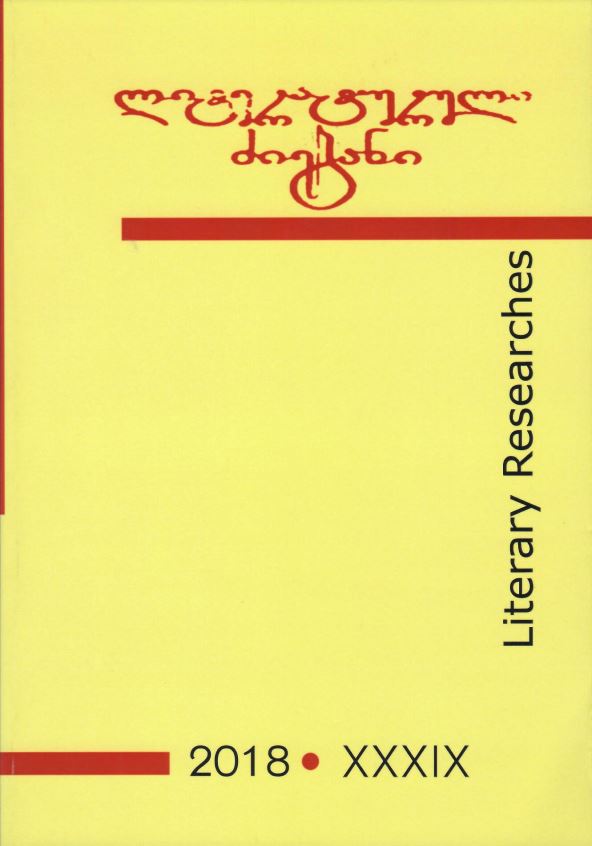“Út pictúra poésis”, that is, “A Verse Resembles a Picture”: (From Technopaegnia to “Ferro-concrete poems”)
Published 2018-12-20
Keywords
- Pattern Poetry,
- Technopaegnia,
- Carmen Figuratum,
- Ferro-Concrete Poems,
- Calligrammes
How to Cite
Abstract
The paper considers the history of visual poetry genre obtained as a result of synthesis of poetry and picture – pattern poetry starting from Hellenism inclusive the first decades of the 20th century. It shows the stages of development of the genre and definite forms of pattern poetry are considered. These are technopaegnia, carmina figurate, and Calligrammes.
The paper states that for definite period the pattern poetry was considered by the literary criticism as a peripheral genre and was seldom found in the sphere of interests of researchers. The author of the paper thinks that terminological non-homogeneity connected with it is a result of scarce interest shown to this genre.
The paper offers Greek, Latin, English, French, German, Russian, Ukrainian, Polish, Croatian, Slovene, Slovak, and Czech material. Samples of Georgian pattern poetry are also discussed.
The work emphasizes the interest of this or that literary movements to definite forms of pattern poetry. Thus, for example: Renaissance exposed samples of technogaegnia and it creates many specimens, but specific interest to it was expressed by Baroque poetry. The author underlines the fact that outlines of technopaegnia created by Hellenism (“Egg” and “Jason’s Wings” by Simmias of Rhodes and “The Alter“ by Dosiados) were reconsidered by the Baroque poets into the Christian symbolic. These samples are “Easter Eggs” by Georgius Stengelius and “The Alter” and “Easter Wings” by George Herbert. It should be emphasized that in the epochs which followed, poets not only imitated the Hellenistic forms but they developed them creatively and as a result of it, range of those patterns, the forms of technopaegnia ,which were formed in the following epochs, are rather vast and they are enriched by the forms of lines of contemporary objects. The paper states that the interest to technopaegnia in the 18th-19th centuries somewhat decreased, although definite samples were still created.
As to carmen figuratum, it was invented by Publilius Optatianus Porfirius. Carmen figuratum played specific role in a matter of strengthening of Christianity in the Early Middle Ages, which is evidenced by the Rabanus Maurus tractate “In Honorem Sanctae Crucis”.
In the first decades of the 20th century pattern poetry returned in the form of Calligrammes of Guillaume Apollinaire and it is connected with the idea of the end of the 19th –20th century to create a new paradigm, synthesis of various movements of art. The author of the paper expresses an idea that there is the principal distinction between Apollinaire’s Calligrammes and early pattern poetry: 1. In distinct from technopaegnia, in which any metrics were used, Apollinaire addresses vers libre; 2. If technopaegnia is a verse in the limits of any concrete object, Apollinaire, similar to a painter, who covers a canvas by painting, places his Calligrammes on the whole page. In the very period, in the first decades of the 20th century “ferro-concrete poems” of Vasily Kamensky, a representative of Russian futurism was created – it is a combination of a painting and a word.
According to the conclusion of the author of the article, in the epoch of Renaissance the interest of poets to technopaegnia should be explained by the attitude of Renaissance to classical literature, while the cause of specific popularity of pattern poetry in the epoch of Baroque is explained by vital significance of all strange, unusual and impressive for aesthetics and world outlook of Baroque. As to the new wave of pattern poetry in the first decade of the 20th century, it is associated with French and Russian vanguard poetry, which received the form of Apollinaire’s “Calligrammes” and Komensky’s “ferro-concrete poetry”. After all, one of the characteristics of vanguard is strife to destruction of borders between the genres and creation of hybrid forms of literature and art.

